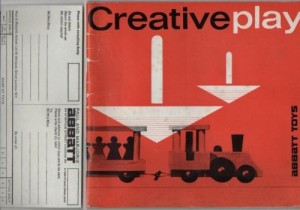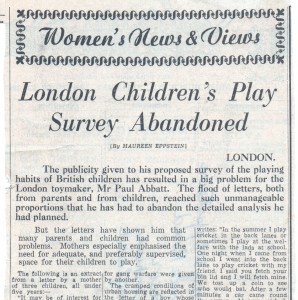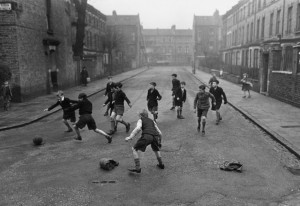Archive for April, 2016
Little boys in their own words
A few months after I interviewed Paul Abbatt, the London toymaker and child development theorist (see my previous blog piece, “An advocate for junk heaps”), I called to ask about his planned survey on what children actually did in their outdoor play. He sighed. The response had been so overwhelming that he’d had to abandon his plans for a detailed analysis. But he did share with me a sampling of the letters he’d received.
The follow-up story I wrote for my New Zealand paper, the Christchurch Press, was published in November 1963. It is transcribed below.
London Children’s Play Survey Abandoned
The publicity given to his proposed survey of the playing habits of British children has resulted in a big problem for the London toymaker, Mr Paul Abbatt. The flood of letters, both from parents and from children, reached such unmanageable proportions that he has had to abandon the detailed analysis he had planned.
But the letters have shown him that many parents and children had common problems. Mothers especially emphasised the need for adequate, and preferably supervised, space for their children to play.
The following is an extract from a letter by a mother of three children, all under five years:–
“It may be of interest for you to know that Crawley is a New Town—the so-called ‘Planner’s Dream.’ It is a ‘Mum’s Nightmare.’ My neighbourhood has no children’s playground, and has not had one for four years. So my children play in the road. Afternoon walks are too often an uninteresting march down roads of which the uniformity is quite paralysing.”
The mother of a boy of eight years says she could do with an attendant in the nearby park, “so that we would not be afraid to let the boy play there alone—an attendant to keep in check the bullying of older boys and help in case of accident with the swings. So, although only 100 yards away, he never goes.”
Many letters from mothers and particularly those from the children, showed children’s love for simple things, and places to make dens. A small boy of 10 gave detailed instructions on how to make a camp in a tree or cave, with the concluding remark: “Then all you need is some things to put in.” Another boy described how he and his friends caught rats on an allotment. A boy of 11 started his letter: “One Saturday when we didn’t know what to do we decided to go on a bike ride.” After several adventures they came to a secret place that one of them knew. “We went down a bank very slowly and we turned into a kind of glade. It was great. There was a stream flowing by and a smashing high tree to climb.”
Looking for the tracks of wild animals was a special memory for one boy, while the letter of another resounded with such names as Steam Engine No. 62004, Class Q.6 and Diesel Deltic, Type 5, No. D9007. Detailed rules for gang warfare were given by another.
The cramped conditions of urban housing are reflected in the letter of a boy whose favourite sport is cricket. He writes: “In summer I play cricket in the back lanes or sometimes I play at the welfare with the lads at school. One night when I came from school I went into the back lane to play cricket with my friends. I said you fetch your bin lid and I will fetch mine. We tost up a coin to see who would bat. After a few minutes a car came round the corner. At seven o’clock my mam came to the door and told me to have a bath. I went in unhappy.
“In the winter when the days are shorter and it’s dark at four o’clock I play football in the lane. Sometimes when it is raining I have a game of football in the yard. One day I kicked the ball that hard, I heard ‘smash’ one pint of milk rolling down the yard.
“Cricket is my best sport. One time my dad was having a game of cricket with me; he was in batting. I bowled, my dad hit it with such a ‘wham’ he smashed the window.”
An advocate for junk heaps

Cover and invoice of a 1964 informational booklet, “Creative Play” published by Paul & Marjorie Abbatt, Ltd. Image from Pinterest
By the time I interviewed him in 1963, Paul Abbatt and his wife Marjorie had spent thirty years as advocates for the importance of play in the development of young children and for the betterment of children’s toys and playing facilities. Toys commissioned by their toy company, Paul and Marjorie Abbatt Ltd. of 94 Wimpole Street in London, won prestigious international awards for their good quality and design. Paul Abbatt, whose chief interest was in ‘the ethos behind the business,’ delivered lectures and contributed to academic and professional journals on child development.
In 1963, Abbatt was focusing on outdoor playgrounds for older children. He commented that
“…as a society becomes more urban and industrialised, it becomes more and more hostile to the child and its needs. As buildings are packed closer and closer together, available sites become too valuable for industry, or for car parks, to be used for children’s playgrounds. Even the upper class child with a garden of his own is no better off, for custom demands that his parents keep their grounds neat and spotless, and the child has no opportunity for such fundamental activities as building a den, or digging down to Australia.
In keeping with the stereotypes of his time, by older children he meant older boys, assuming that a girl would be “already a mother with dolls, kitchen, a little house of her own.” The interview continues:
Mr Abbatt believes that the solution to the needs of the older child can be found in the adventure playground. The first of these was built several years ago in Copenhagen, where the designer, instead of putting in the usual concrete shapes, swings and slides, filled his playground with builders’ junk. The playground was a great success, and was copied all over Europe. Some cities produced old cars, or traction engines, used tires, and even an old boat.
The first experimental playgrounds, with their carefully manufactured playing facilities, had not been a success. The children were interested at first, but quickly gravitated to the streets just outside the playground, where they were closer to the real life that they knew. But when the material was provided on the sites for them to build their own dens, they could create their own world inside the playground. “Building a den seems to be fundamental to children’s play, and other activities develop round the original den,” said Mr Abbatt. In Zurich, for example, the gang who inhabited one playground built up such a community spirit that they had their own bank with its own play money, a duplicated magazine, an antique shop, and even a farm with a dozen ducks on a man-made pond. When each gang deserts the playground, as they eventually do, the dens are pulled down, and the next gang to come along starts from scratch with the pile of junk.
In the meantime, in Copenhagen, the first adventure playground has become something of a showplace for visiting social workers. The grounds have been tidied up, and the rough dens turned into pretty villas. The visitors look and admire, but the children no longer come.
Similar problems affect playgrounds in Britain. They are normally noisy, untidy, derelict places, a disgrace to the neighbourhood of neat houses with even neater gardens. So local residents complain, and the council tidies up the playground. “In doing so, they destroy the urge for creative activity that the previous junk-heap gave to the children,” said Mr Abbatt.
In preparation for a conference of the International Council for Children’s Play, which Abbatt helped found, he is making a descriptive survey of children in Britain.
He has invited parents to write and tell him what their children do, and, since small boys particularly are notoriously uncommunicative about the activities of their gangs, he is also seeking information from policemen, schoolteachers, traffic wardens, and others who see the children outside their homes. Already the response from parents has been overwhelming.
He hopes that the survey will provide town planners, architects, and designers, with information on what children really want out of their community.
In a note to my editor, I promised a follow-up when the survey results were in. I’ll talk about that in my next blog piece.

